

Pigs in the City
Regina, Saskatchewan
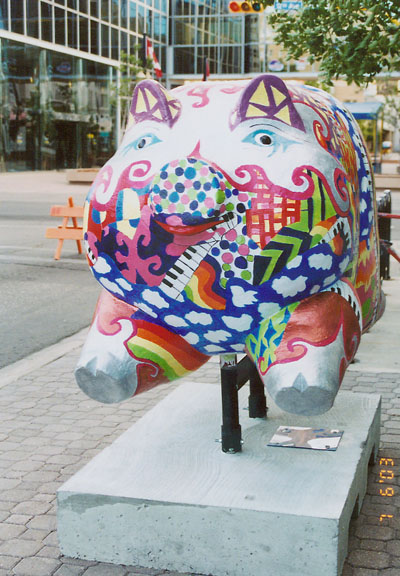
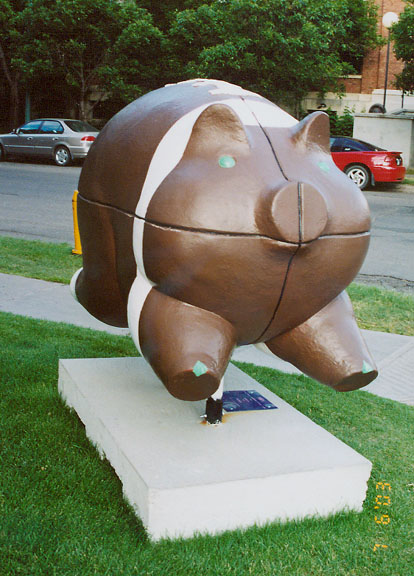
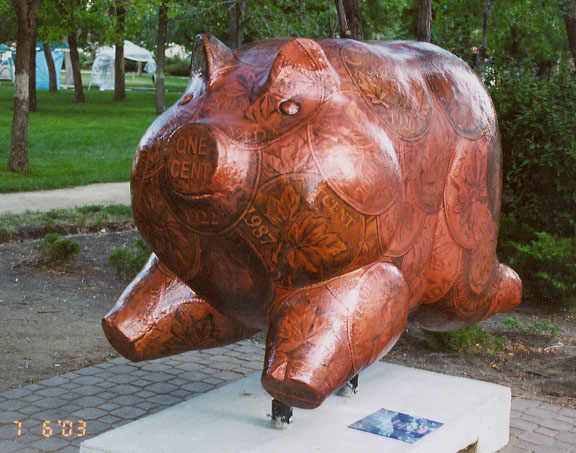
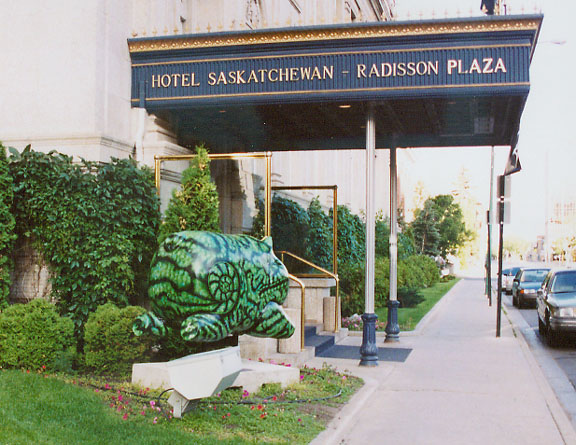

![]()

RCMP
Royal Canadian Mounted Police (RCMP), the Canadian national law enforcement agency and an enduring symbol of the country. Established in 1873 as the North-West Mounted Police, a horseback troop, the force had a leading role in the settlement of the Canadian West. Today it employs nearly 16,000 peace officers, who are called Mounties.
The RCMP is directed by a commissioner located at the force's headquarters in
the national capital, Ottawa. There are more than 700 detachments across Canada,
with about 5000 civilian employees in addition to the officers. The Mounties
enforce federal laws throughout Canada, provincial laws in eight of the ten
provinces, and municipal ordinances in many municipalities. Currently, they are
the only police in the Yukon Territory, the Northwest Territories, and the new
Nunavut Territory, a situation that could change if tribal police forces are
established in these northern regions.
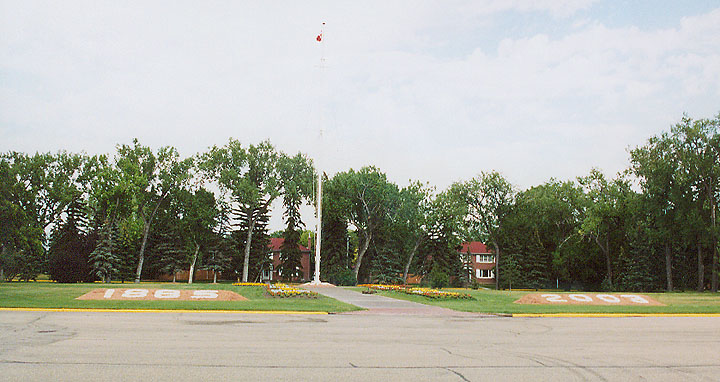
parade ground at the training facility in Regina
The RCMP's major areas of national attention are the narcotics traffic; organized crime; commercial and economic crime, including money laundering and the new area of computer and telecommunications crime; and terrorism. The force operates marine and air divisions and five crime laboratories. The modern Mountie travels by airplane, automobile, boat, snowmobile, and power toboggan.
Applicants to the force must be Canadian citizens of good character. To be
officers, they must be at least 19 years of age, graduates of the 12th grade,
and in good physical condition. Those who are accepted as officer cadets must
enlist for five years. They take a basic six-month training course.

memorial to the Mounties
In the late 1860s the new Dominion of Canada acquired Rupert's Land, a vast
region of prairies, mountains, forests, and tundra, from the Hudson's Bay
Company. Settlement of this wilderness would inevitably disturb the lives of the
indigenous peoples, particularly those who hunted bison, also called buffalo.
Consequently, the Canadian government decided to establish law and order on the
frontier before allowing settlement so that Canada could avoid the experience of
the United States, where the Western frontier was the scene of bloody warfare
between indigenous peoples and white settlers.
Prime Minister Sir John A. Macdonald looked to the British Empire for models of
policing.
In 1869 the Royal Irish Constabulary was adopted as a model for a centralized, paramilitary force that would keep order until settlement was complete. However, before the force could be organized, the most settled part of Rupert's Land, the Red River colony, became the scene of the Red River Rebellion, a resistance against the transfer to Canadian rule. After the resistance, the area around the Red River colony became the province of Manitoba, responsible for its own law enforcement.
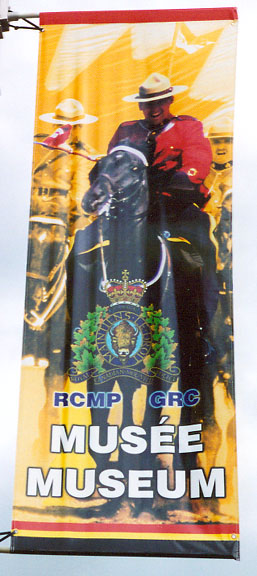
the museum
The remainder of Rupert's Land, now called the Northwest Territories, still needed policing. This was brought home to the Canadian Parliament in 1873, when 20 to 30 members of the Assiniboine nation were massacred by American wolf hunters in the Cypress Hills. Parliament passed an act to begin recruiting for the new force, and by the spring of 1874 the North-West Mounted Police had 300 recruits. The force's first commissioner was Lieutenant Colonel George Arthur French. Below him were commissioned officers, of the rank of superintendent and inspector, and noncommissioned officer ranks of staff sergeant, sergeant, corporal, and constable. The force was not only a policing agency: Its commissioned officers could serve as justices of the peace, with limited authority to conduct trials at law.
Lightly armed, using horses for mobility, and clad in striking scarlet tunics,
the new force moved west that summer in a long march from Manitoba across the
prairies to present-day southern Alberta. There, people from Montana had set up
a trading post and were illegally trading whiskey to indigenous peoples. When
the Mounties arrived in September 1874, they promptly arrested the traders, thus
earning the respect of Chief Crowfoot of the Blackfoot nation. This set the tone
for generally good relations between the Mounties and the indigenous peoples.
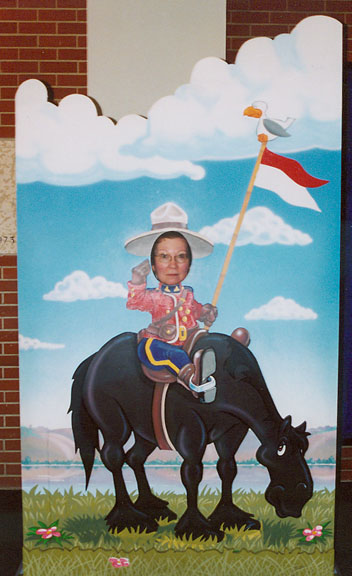
every tourist a Mountie
In the mid-1870s the Mounties built a network of posts in present-day Saskatchewan and Alberta, including Fort Macleod, Fort Calgary, and Fort Walsh. Eventually they extended this network throughout the territories, with regular patrols sent out from each post. The whiskey trade was soon brought under control. The Mounties mediated conflicts between indigenous peoples and settlers. They also worked with the indigenous peoples in preparation for their signing treaties with the Canadian government. By 1877 most of the peoples of the southern prairies had signed treaties, thus opening extensive areas to settlement.
By the early 1880s, the force on the frontier had increased to 500, but unrest
was growing among the Métis, a people descended from both indigenous and
European ancestors. The Métis suffered from the disappearance of the great bison
herds, which they had hunted, and from crop failures in the early 1880s.
Warnings to Ottawa about growing unrest went unheeded, and in 1885 a resistance,
the Northwest Rebellion, broke out, led by Louis Riel and Gabriel Dumont of the
Métis community. The Métis defeated a Mountie detachment in the Battle of Duck
Lake on March 26, 1885, but soon troops came from the east and quelled the
resistance. Few members of other indigenous peoples joined the Métis resisters,
reflecting the degree of trust that the Mounties had established.
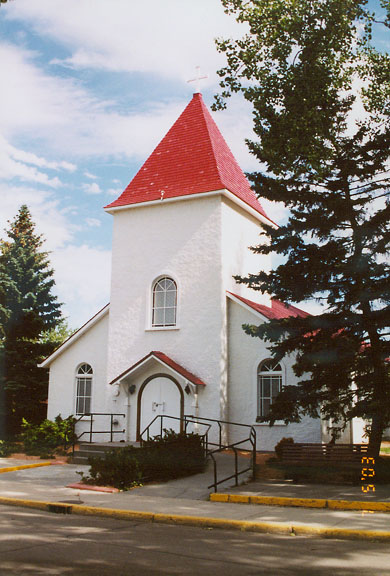
the RCMP chapel at the training center in Regina
After the rebellion, the government quickly increased the force's strength to
1000. A new commissioner, Lawrence W. Herchmer, was appointed with a mandate to
improve the force's structure and operations.
The Mounties had been intended as a temporary force that would disappear when
settlement was complete, and by the 1890s Parliament was being urged to save
money by terminating the force. The Liberal Party won office in the 1896 federal
election with a pledge to disband the Mounties. However, they soon discovered
that the force was popular in the West. Renewed tensions between indigenous
peoples and settlers also increased pressure to maintain the Mounties' presence.
When Saskatchewan and Alberta became provinces in 1905, they arranged with the
North-West Mounted Police to act as the provincial police.
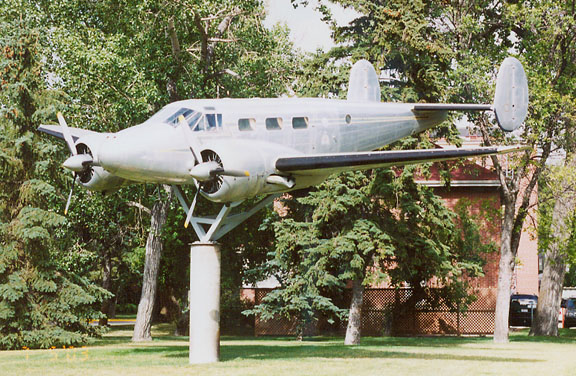
Aircraft used to patrol the frontier
In 1896 the force dispatched 20 officers to the Yukon upon hearing of gold discoveries in the Klondike region. The next year the Klondike gold rush brought hordes of prospectors. The presence of a Mountie detachment, increased to 250 by 1899, ensured that a potentially chaotic situation was in fact orderly and law abiding. By the beginning of the 20th century, the force also moved into other parts of the far north, establishing a post north of the Arctic Circle at Fort McPherson in 1903 and another on the western shore of Hudson Bay. The Mounties asserted Canadian sovereignty and enforced law and order over Canada's last frontier.
During World War I (1914-1918), the force-now called the Royal North-West
Mounted Police-took on national duties in the areas of security and
intelligence. However, its provincial role was interrupted in 1917 when Alberta
and Saskatchewan passed Prohibition laws, which outlawed the sale of alcoholic
drinks. Commissioner A. Bowen Perry declared prohibition unenforceable and
canceled the policing contracts for the two provinces. The strength of the force
dwindled further as its members were recruited into the military. Many,
including Perry, believed it would not last into peacetime.
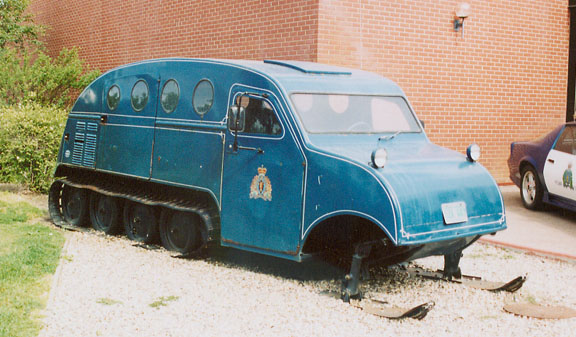
vehicle for crossing the ice
After the war Newton W. Rowell, a federal cabinet minister, was sent across western Canada to assess the future of the Mounties. The options were either to eliminate the North-West Mounted Police or to expand it to become a national police force. When labor unrest swept western Canada and culminated in the Winnipeg general strike of 1919, the balance was tipped toward expansion. The Mounties were merged with the Dominion Police, who had enforced federal laws since 1868 in central and eastern Canada, and on February 1, 1920, were renamed the Royal Canadian Mounted Police. During the 1920s they were especially concerned with subversion and narcotics control. The force also extended its presence in the north, using a ship, the Saint Roch, as a floating post in the Arctic islands and carrying out pioneering dogsled expeditions across the eastern Arctic.
Major General James Howden MacBrien, who was commissioner from 1931 to 1938,
directed an expansion and modernization of the force. Training was expanded, and
advanced methods of criminal investigation were promoted, including the force's
first forensic laboratory. An aviation section was added. Six provinces,
including Alberta and Saskatchewan, contracted for policing services (two more
were added in 1950). The number of officers rose to 2350.
World War II (1939-1945) brought new responsibilities in national security and
counterespionage. Potential enemy collaborators were identified and interned.
Close liaisons were established with foreign police and security agencies,
especially the Federal Bureau of Investigation in the United States.
Counterespionage and countersubversion activity became particularly important
functions of the RCMP after 1945, when Igor Gouzenko, a cipher clerk for the
Union of Soviet Socialist Republics in its Ottawa legation, defected and turned
over evidence of Soviet espionage. The Cold War, a 40-year period of hostile
relations with the Soviets and other Communist countries, had come to Canada.
For most of the next four decades the RCMP was in the forefront of
counterespionage and countersubversion activity against the threat of Communism.
In the 1960s two relatively minor security scandals became media sensations and
led to creation of the Royal Commission on Security. The commission's report, in
1968, recommended that the security function be given to a civilian agency. This
recommendation was rejected by the government.
In the late 1960s the force refocused its security work toward an internal
threat from terrorists seeking independence for the province of Québec. In
October 1970 a terrorist group, the Front de Libération du Québec, kidnapped the
British trade consul in Montréal and kidnapped and murdered the Québec minister
of labor, Pierre Laporte. After this crisis the government instructed the
Mounties to intensify their undercover operations in Québec. They did so
successfully, but some of their methods-break-ins, barn burnings, and other
actions of dubious legality-caused a series of scandals in the 1970s. In 1981 a
commission of inquiry again recommended that the RCMP's security and
intelligence functions be transferred to a civilian agency. This time the
government acted, creating the Canadian Security Intelligence Service in 1984.
The Mounties still retain responsibility for investigating criminal acts of
espionage or terrorism.
Text from Microsoft Encarta
![]()
![]()